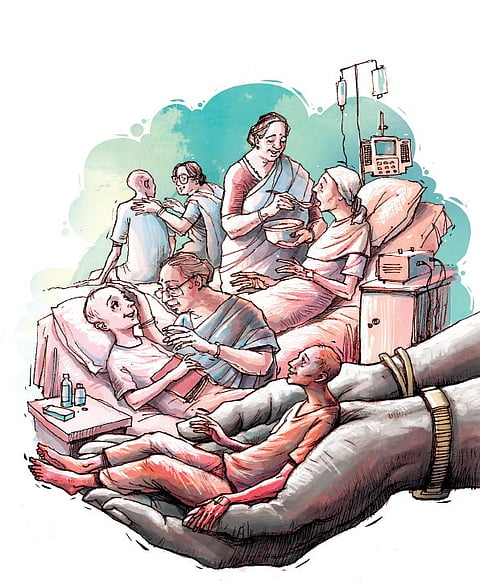A case for cancer care
KOCHI: Cancer incidence in India is estimated to be 19 to 22 lakhs in 2022 while actual incidence may be 1.5 to 3 times higher. This high burden of cancer incidence in India is resulting in high economic burden because of productivity losses and premature mortality.
There are many gaps in patient journey
More than 50% of patients are diagnosed after they are symptomatic with most of them diagnosed in stage 3 & 2 and about 20% in stage 4. It’s very rare to see patients in stage 1.There is a delay of more than two weeks in rural areas in concluding the diagnosis of cancer because of lack of expert clinicians and pathologists.
There is a gap in information about the availability of cancer diagnosis and treatment in rural areas. For example, in Telangana, there is only one regional cancer institute, MNJ Cancer Hospital with very long wait to see a clinician, a longer time to diagnose because of high burden of cases and a long wait to get treated with waiting lists for radiation or surgery. In Andhra Pradesh, there is no government regional cancer institute, and many patients travel to MNJ. And a huge gap is there in rehabilitation and practically nil psychological care. Estimates indicate that the cancer incidence will increase to 250 to 280 per lakh population by 2030 which will burden the present infrastructure unless government starts new centers.
Prevention also calls for a multi-stakeholder approach involving governments, healthcare workers, NGOs, community support groups and most importantly the public who need to engage in healthy behaviours for their own well-being.
Assessing the disparities in the access and quality in cancer care needs to be done in terms of geography like gaps in cancer care in rural and urban areas, socioeconomics in different economic groups, technological accessibility in different regions and barriers in timely diagnosis and treatment. We can know the gaps after these studies and propose changes to improve cancer care and treatment.
By employing a combination of these methods, healthcare systems can gain insights into existing disparities, allowing for targeted interventions to improve access and quality in cancer care for all populations.
Approaches to bridging the gap
Exploring telemedicine solutions can bridge the care gap in cancer treatment, offering remote consultations, monitoring, and support. Additionally, leveraging Artificial Intelligence (AI) for data analysis can help assess disparities in access and quality. By identifying patterns and trends in healthcare data, we can pinpoint areas that require intervention and ensure equitable distribution of resources, ultimately improving outcomes for all patients. Innovation lies in combining technology with a compassionate, patient-centered approach to transform cancer care and address disparities comprehensively.
Telemedicine and remote monitoring: Implementing telemedicine solutions allows patients to access consultations, follow-ups, and support remotely. This is particularly beneficial for those in geographically distant or underserved areas, reducing the need for extensive travel.
Mobile health (mHealth) apps: Develop user-friendly mobile apps to empower patients with information, appointment reminders, and support services. These apps can also facilitate communication between patients and healthcare providers, promoting a more patient-centric approach.
Community health workers: Train and deploy community health workers to serve as liaisons between healthcare facilities and local communities. They can provide education, support, and help navigate the complexities of the healthcare system, improving access to cancer care.
Patient navigation programmes: Establish patient navigation programmes to guide individuals through the healthcare system. Navigators can assist with appointment scheduling, insurance coordination, and addressing barriers to care, ensuring a smoother patient experience.
Financial assistance programmes: Create innovative financial assistance programmes to alleviate the economic burden of cancer treatment. This could include subsidies, grants, or partnerships with pharmaceutical companies to provide affordable medications.
Multidisciplinary cancer care clinics: Integrate various cancer care services into multidisciplinary clinics, offering a one-stop-shop for diagnosis, treatment, and support. This approach streamlines care and ensures a holistic approach to patients’ needs.
Technology for education and awareness: Leverage technology, such as virtual reality or augmented reality, to create immersive educational experiences about cancer prevention, early detection.
Significant gaps in awareness about cancer risks, symptoms, and warning signs can be tackled by awareness generation through targeted messaging by digital, AI. Absence of testing in screening programmes can be tackled by creating point-of-care devices for easy and faster screening through AI, ML (Machine learning is a type of artificial intelligence that learns from historical data). Lack of trained specialists for diagnosis, e.g., radiologists can be tackled by machine learning algorithms and clinical decision support tools that can help reduce the specialist’s burden through clinical decision support system (CDSS) and ML. Lack of access to quaternary care settings or expert oncologists across the country can be tackled by using technology for information sharing and second opinions for example digital pathology and telemedicine platforms.
Lack of clinical pathway to track the patient journey from screening, diagnosis, and treatment We can use an app/digital platform that cuts across all patient touchpoints. The lack of a standardised platform does not record patient details and medical records to be used
across care settings — this can be tackled by AI and hospital record systems. Adequate training to use telemedicine platforms to initiate training from experts across public and private organisations.
(The writer is a consultant robotic onco surgeon, Apollo Cancer Centres, Hyderabad)

